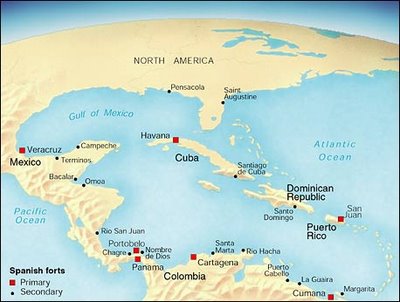The Spaniards constructed an elaborate system of fortifications across the Caribbean basin: from Veracruz, from which the fleet carrying Mexican silver would sail; to Panama and Nombre de Dios, through which Peruvian and Philippine treasure was routed; on to Havana, where the fleets converged; and San Juan, Puerto Rico, which Philip II called "the key to the Indies."

The walled city of San Juan, and the El Morro fort that guards its harbour, are particularly impressive. The first defences were constructed in the sixteenth century, and helped repel Drake's 1595 attack. Three years later, another English privateer, the Earl of Cumberland, took the fort by attacking overland rather than from the sea, but this expedition was defeated eventually as his men succumbed to dysentery. The Spaniards then rebuilt El Morro stronger than ever, and saw off a Dutch attack in 1625. Further building continued for another 150 years, producing massive walls and further forts all around the island on which Old San Juan sits.
El Morro was subject to US bombardment during the war of 1898, but the Americans subsequently themselves rebuilt parts of the site in World War II pillbox fashion, turning it into a lookout now against the possibility of German U-Boats advancing across the Atlantic.

But although the prodigious engineering that went into this edifice is ascribed to the Irish-born Colonel Thomas O'Daly, surely this architecture of counter-insurgency should also be credited at least in part to the nomadic pirates against whom it was arrayed?
No comments:
Post a Comment